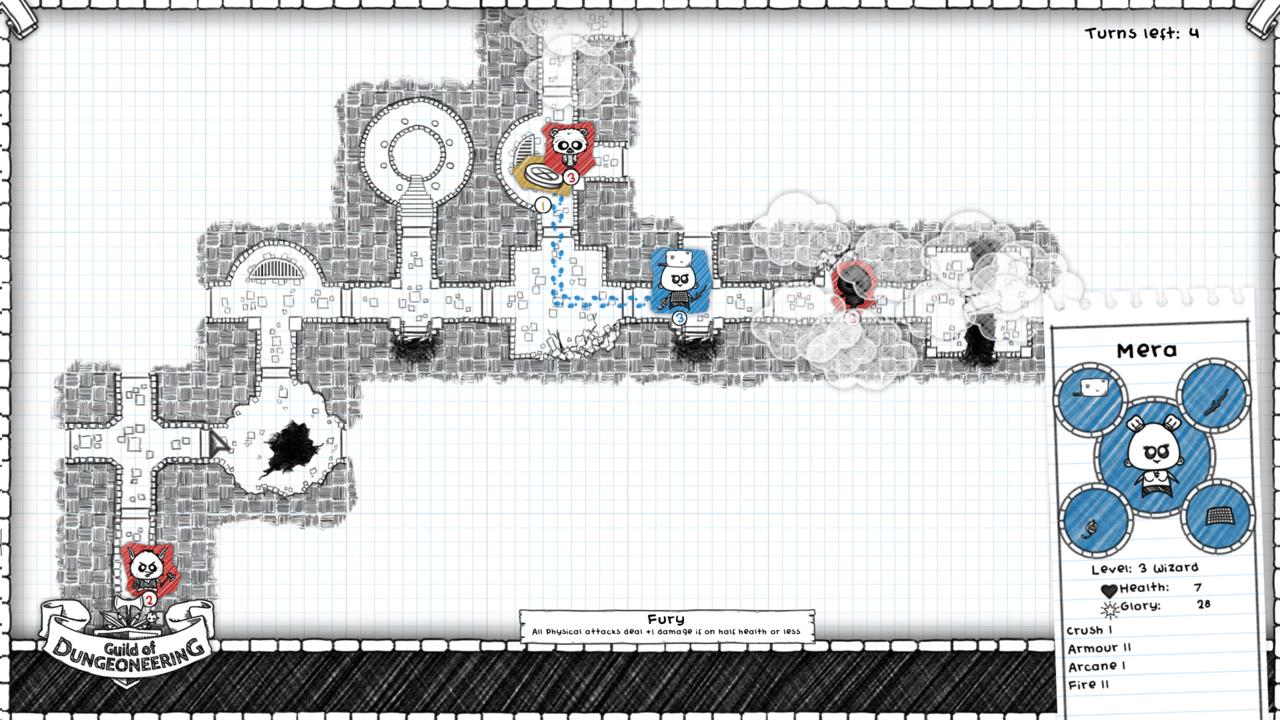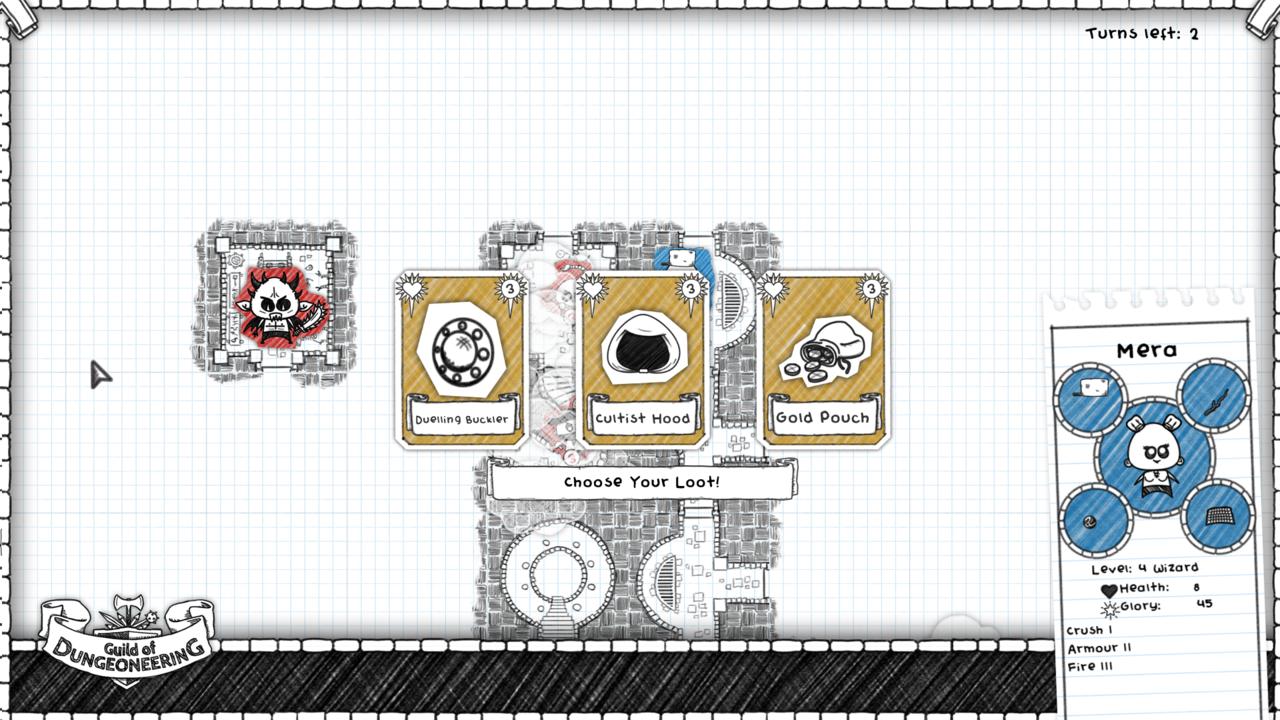It resembles the graph-paper drawings I scribbled when crafting Dungeons & Dragons scenarios during my childhood, though is far more attractive. This is the first thing I notice about Guild of Dungeoneering when I sit down to play it, and game designer Colm Larkin tells me the similarity is no accident. This unusual role-playing/card-battling game not only uses its graph-paper art style in order to evoke those halcyon days of tabletop gaming, but even draws inspiration from D&D’s monsters. "Do you know the classic D&D Owlbear?" Larkin asks me. "My artist Fred [Mangan], I had him do an owlbear, and for a laugh, he did the bearowl, which is the body of an owl and the head of a bear."
An owlbear is a scary beast; Guild of Dungeoneering's bearowl, on the other hand, is adorable in its awkwardness, appearing as a small ink drawing on a tiny paper token that looks to be ripped from the corner of whatever notebook happened to be laying around. It is not the center of the short Guild of Dungeoneering demo I recently played in Larkin's company, however. That honor belongs to a wizard named Mera, who is one of several heroes who will be playable when the game is released later this year. Yet even the word "playable" seems a bit of a misnomer in this case, for you do not directly control the adventurers that explore these dungeons. Instead, you create the dungeon, placing corridors, rooms, and enemies on the gameplay grid, hoping to lure Mera--or whomever might be seeking fame and fortune--with promises of powerful equipment and vast riches.

Here's how it works: with each turn, you draw multiple cards from your adventuring deck, and choose three to play or discard. Some of these cards represent new rooms and hallways, and you attach them to your dungeon-in-progress by dragging them into place. In the demo's case, my ultimate destination is the fire demon that serves as the dungeon’s boss. Should I lead Mera to him within a certain number of turns by connecting the dungeon to his lair, he won't be as powerful as he will be if he leaves his lair and comes after Mera when the turn countdown expires. Other cards represent creatures and treasures, which you drag into slots in the rooms and corridors--one slot per dungeon module.
I am reminded of 2000's Majesty, a strategy game in which you had no direct control of the heroes you sent into the wild unknown, and Larkin is clearly familiar with the game. "They often went one by one to their deaths," he says about Majesty's heroes, and tells me that Guild of Dungeoneering's recruits exercise their own form of free will--which means that things may not always go as you plan. "So there's a bit of that frustrating silliness, which I'm OK with," Larkin says. Besides, heroes are a dime a dozen, as it turns out. Says Larkin, "You, the player, are running a guild. You can hire heroes, which are totally expendable, like interns, essentially. You get them from the tavern and send them to their deaths."
Another Crab's Treasure Is A Soulslike 3D Platformer | GameSpot Review Stellar Blade Review Super Monkey Ball Banana Rumble - Official Multiplayer Features Trailer Nintendo 64 – April 2024 Game Updates – Nintendo Switch Online PUBG | Erangel Classic Returns Gori: Cuddly Carnage | Meow Launch Date Announcement Trailer Genshin Impact - "Arlecchino: Afterglow of Calamity" | Collected Miscellany Marvel Rivals - Official Loki Character Reveal Trailer | The King of Yggsgard Fortnite Festival - Official Billie Eilish Cinematic Season 3 Trailer Remnant 2 - The Forgotten Kingdom | DLC Launch Trailer Stellar Blade - Official "The Journey: Part 2" Behind The Scenes Trailer | PS5 Games Dead by Daylight | Tome 19: Splendor | Reveal Trailer
Please enter your date of birth to view this video
By clicking 'enter', you agree to GameSpot's
Terms of Use and Privacy Policy
I'm delighted by the way rooms are drawn into place as I drag cards onto the playing grid, as if they are sketched quickly into place by an invisible artist. It's a lovely aesthetic, not one you would call beautiful at first glance, but loaded with charm and detail when you take a closer look. But guiding Mera through the dungeon means not just admiring the art, but also facing monsters, and when it's time to face your foes, a different deck of cards comes into play.
When combat begins, you draw three battle cards, as well as a new one after each turn to replace the one you played. Guild of Dungeoneering doesn"t let you customize your deck like a collectible card game. As Larkin tells me, "You don't get to do it by hand. You don't get to open the deck and go, 'I want this card, and this card, and this card'--it's all automatic. It's all based around choosing equipment." You come by that equipment by beating monsters in battle, or by opening treasure chests. There are no stats or skill trees in the traditional sense. Instead, you earn new attacks, passive buffs, defensive items, and other doodads by equipping the armor and weapons you find on your travels. Those items, in turn, determine which cards are available in your battle deck.

The battles are straightforward enough, with each card, whether it be mine or my enemy's, clearly indicating what it does, making it easy to determine the outcome of the turn before you play your chosen card. As I progress, Mera bumps into fire imps and skeletons, but none of them is any match for her magic spells--until I fail to reach the fire demon within the allotted turn limit, and he goes on the hunt. I play my cards as smartly as I know how, but Mera is toast--quite literally, I imagine, burnt to a crisp by the demon's hot halitosis. Of course, I have to imagine such a scenario: Guild of Dungeoneering represents its characters with cute little cutouts that glide around the map. But I am reasonably certain Mera has become crunchy demon food.
There will be more available adventurers to lure with gold and goblins, though Larkin isn't sure just how many there will be. You will discover new ones on your travels; for instance, should you encounter a thieves’ den, you will then be able to recruit thieves to your guild. Guild of Dungeoneering is such an unassuming game, an anti-blockbuster if ever there was one. Yet it is one of the most interesting games I’ve played in months, and the kind I can see myself losing many hours to when the full release makes its way to my PC this spring.

